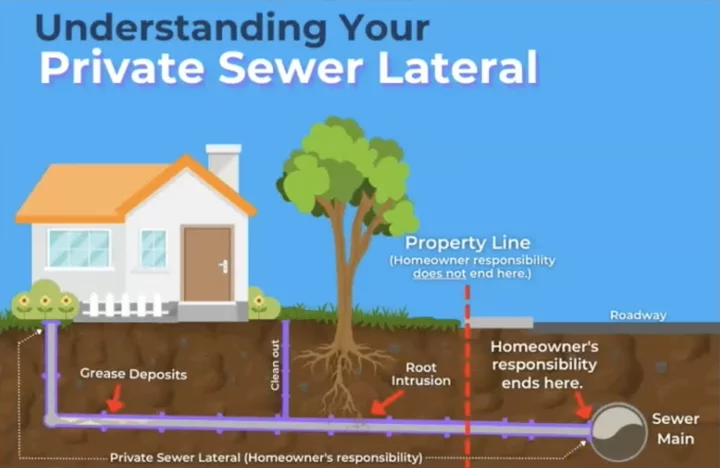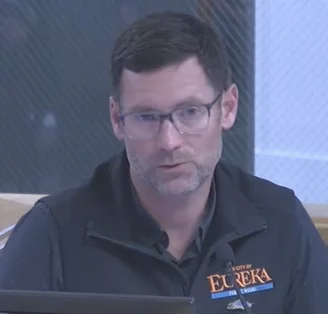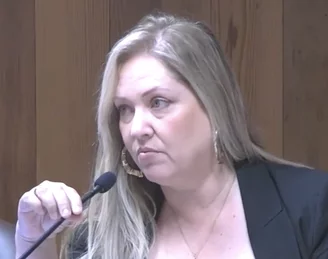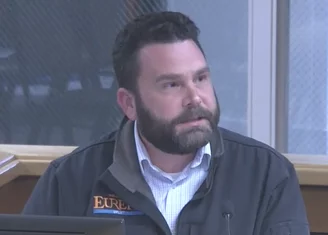Graphic: City of Eureka
###
###
Despite widespread opposition from local realtors and homeowners, the Eureka City Council on Tuesday narrowly approved an update to the 2025-26 fee schedule that increases the cost of sewer lateral replacement for property owners with aging plumbing. The item passed in a 3-2 vote, with council members G. Mario Fernandez and Renee Contreras-DeLoach dissenting.
The updated fee schedule increases the “fee in lieu” rate for standard sewer lateral installation from $8,000 to $9,000. Costs for “non-standard installation” — complex cases where laterals are deep and difficult to access — will be determined by the city’s engineer.
A little bit of background: The “fee in lieu” system was introduced after the city council adopted the Private Sewer Lateral Ordinance in 2019, which shifted the responsibility of lower laterals — the section of sewer pipe that runs from a building’s property line to the sewer main beneath the street — to property owners. Under the ordinance, homeowners are responsible for blockages occurring anywhere in the lateral.
Not long after the ordinance was enacted, staff reported ongoing issues with property owners failing to replace laterals when necessary, largely due to the cost. To alleviate the issue, the council set up a “fee in lieu” system that gives property owners the option of paying a set fee that allows staff to undertake repairs on their behalf.
“We give folks an opportunity to basically pay into that project at … a 20 percent discount [of] what the actual bid cost was for the project, in order to have an easy way to have it taken care of,” City Engineer Jesse Willor explained at Tuesday’s meeting. “You pay a fee, and it’s taken care of for you. … It also provides an opportunity for the lower [lateral] to be done by a private contractor if the homeowner chooses.”
When the ordinance was amended, staff wrote in a point-of-sale trigger that requires a private contractor to inspect the lower lateral upon the sale or transfer of a property. If an inspection determines the lower lateral to be defective — or if it’s made of clay — it must be replaced.
Several local realtors asked the council to reconsider the fee hike during the public comment portion of the meeting. Eureka real estate agent Suzy Smith read a letter on behalf of the Humboldt Association of Realtors urging the board to lower the “fee in lieu” for standard private lateral replacement to $4,000, and cap “non-standard” installation at $8,000.
“A major issue is the current uncertainty that when you are selling or buying a property in Eureka, as soon as you initiate the sewer lateral certification application process, you may be writing a blank check to the city for your lower lateral, not including how much you will need to pay your private plumber for the upper lateral work, if required,” Smith said.
Victoria Copeland, a realtor with Key Real Estate Group, agreed. “You guys have the ability to set the fee in a reasonable, equitable way for property owners,” she said, urging the council to go “50/50” with homeowners.
Eureka homeowner Ellen P. argued that the fee increase could “make the homeless problem here much worse” and asked what happens if residents can’t afford repairs.
“What if this is too exorbitant, and my sewer does start to back up. What happens then?” she asked. “Is there going to be a lien on my property? Am I going to get foreclosed on again? If Eureka is serious about tackling our homelessness issue, this seems like a really bad idea. … [This] is just a recipe for people getting kicked out of their homes.”
Early on in the meeting, Councilmember Contreras-DeLoach indicated that she would vote against the rate increase because “people are broke.” She added that she would be “very uncomfortable with [the city] continuing to increase rates on ratepayers” whose salaries aren’t increasing at the same rate.
After making a motion to approve the fee hike, which was seconded by Councilmember Kati Moulton, Councilmember Leslie Castellano acknowledged that “no one wants to raise fees in general,” but the alternative is passing fees on to ratepayers.
“If we don’t have building owners pay for sewer lateral replacements, then it has to be paid somehow, right?” she asked staff. “It would have to be passed on to ratepayers, generally speaking, which would be more renters, more people who maybe aren’t benefiting from home ownership.”
“It would be across the entire rate-paying base, both commercial and residential,” said City Manager Miles Slattery, adding that technological advances could potentially cut costs. “There are technologies that are out there that aren’t necessarily up here, that could significantly reduce these costs. … Technology can change. Materials costs can change. A lot of things could change to make that difference.”
Councilmember Fernandez asked if staff had any idea how many laterals have been replaced to date and how many still need to be replaced. Willor said staff are almost done inspecting the city’s system, which has been done with CCTV cameras. Once that project is complete, staff will have a clearer picture of how many defunct laterals remain.
“We’re almost to the point [where] we have that data,” Willor said. “We don’t have the condition index of all of them, but we can say that we know how many we’ve replaced, and we know how many remain.”
Fernandez also expressed concern about equity. “I would rather that this public utility, at least through its usage for a public good, be a shared cost,” he said. “Is that something that is going to be solved tonight? No, but I would rather not increase it if that were the case.”
Councilmember Moulton acknowledged that owning a home “can be a money pit,” but agreed that the financial burden of lower lateral replacement should fall on homeowners.
“The fundamental piece of this for me is who owns a sewer lateral,” she said. “If that house were not there, there would be no connection to the public sanitary sewer. Therefore, that sewer, that specific piece of pipe, is serving that house, and in my mind, that makes it the responsibility of that property owner. … I think that the city offering to transfer 20 percent of the average cost to other people who are not building equity in that property is incredibly generous.”
After a bit of additional discussion, the council passed the motion in a 3-2 vote, with council members Contreras-DeLoach and Fernandez dissenting.
###
An in-progress shot of the transitional housing units being assembled. | Photo: City of Eureka
Bayside Village Welcomes Residents
After nearly eight years of planning and numerous setbacks, formerly unhoused people are moving into their new digs at Bayside Village, the long-awaited transitional community housing project at the foot of Hilfiker Lane in Eureka. Once everyone’s all moved in, the “ultra-low barrier” facility, often referred to as the Crowley Project, will house approximately 38 people and their pets.
In a presentation to the city council at this week’s meeting, Jeff Davis, project manager for the city’s CAPE and Uplift Eureka programs, said he hopes to have everyone moved into their new homes by the end of next week.
“The dining and laundry facilities, the restrooms and all but two of the residential units are up and running,” Davis said, adding that the project is grant-funded. “As of today, there are 28 individuals, 14 dogs and three cats that are residing at Bayside Village. … The goal is to continue moving folks in this week, and by the end of next week, to be fully at full capacity [with] at least 38 folks on site and additional dogs and pets, up to three per unit.”
Davis shared pictures of people’s pets and quotes from new residents — “Very grateful for a new lease on life” — many of whom have lived along the waterfront trail for 10 to 15 years. One of the new tenants has been homeless for over 35 years, Davis said.
Staff with the Betty Kwan Chinn Homeless Foundation will help manage the site, and the city’s Uplift and Crisis Alternative Response Eureka (CARE) teams will provide on-site supportive services and programming to help residents get back on their feet and move into more permanent housing.
“As soon as folks are housed through a variety of other programs, the idea is to turn this over and open this up for more folks,” Davis said. “We’re still working with folks that maybe weren’t the first 38 people to move in, but we’re still keeping up with them. We’re still providing outreach services and supportive services. … I didn’t know [this would take] several years, but it’s a reality today and I know the folks on site are extremely grateful.”
Responding to Mayor Kim Bergel’s question about children living at Bayside Village, Davis said there is a family moving in, but their kids are now legal adults. “There are several [children] that visit their parents … but there are currently none that reside there.”
Asked about the rent rate, Davis said the rent is “pretty low,” but if residents don’t have the funds, the Better Kwan Chinn Foundation will pay their rent through a scholarship or sponsorship program.
“If they are able to pay, once they leave [the program] for permanent housing, every penny that they paid they’ll be getting back,” he added. “So they’ll have that to pay for a deposit or for moving expenses, in addition to accruing the rental history.”
Each member of the council expressed their gratitude to the staff who made the project a reality, even if it took a few years longer than expected.
“This has taken a lot of endurance and perseverance … and just really appreciate you and everyone who’s been involved along the way,” Castellano said. “There are many hard things happening in the world, and I feel really proud to see the things that we’re working on. Just thank you so much.”
###
Click here for more coverage of Tuesday’s meeting.






CLICK TO MANAGE